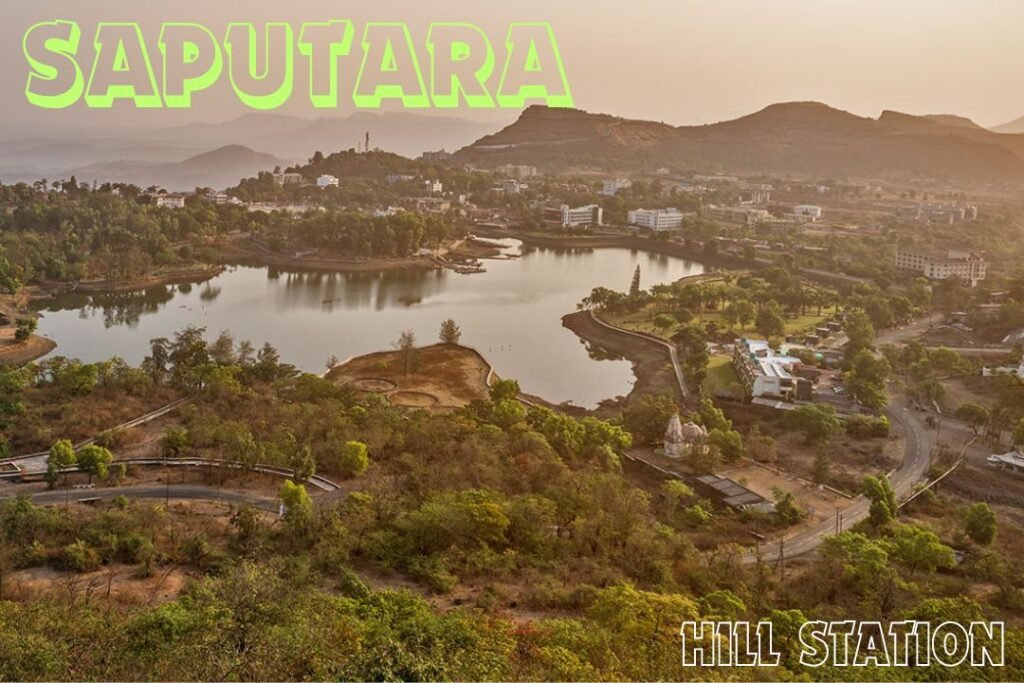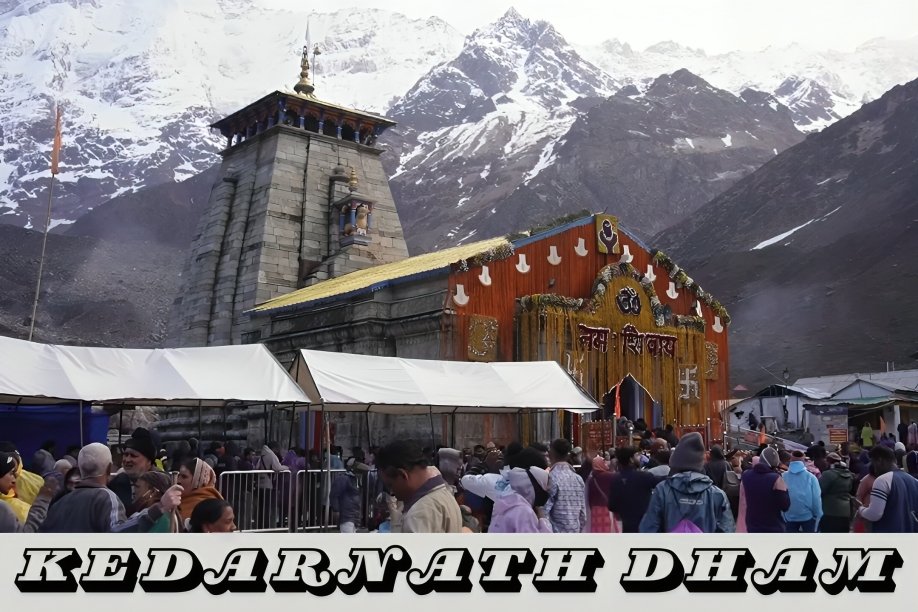Gangotri, a small town in the Uttarkashi district of the Indian state of Uttarakhand, is a place of immense spiritual and cultural significance. Perched at an elevation of 3,100 meters (10,200 feet) above sea level in the Garhwal Himalayas, Gangotri is not only the origin of the sacred River Ganges but also a prominent pilgrimage site for Hindus. The town is one of the four sacred sites that make up the Chota Char Dham Yatra, a pilgrimage that includes Yamunotri, Kedarnath, and Badrinath. Gangotri, in particular, is revered for its association with the goddess Ganga, who is believed to have descended from heaven at this very location.
For centuries, devotees, saints, and spiritual seekers have journeyed to Gangotri to pay homage to the goddess and to experience the serenity and purity of this sacred place. The town is enveloped in a spiritual aura, with the majestic Himalayas serving as a fitting backdrop to the divinity of the Ganges. Gangotri is not just a destination; it’s a profound experience of spiritual awakening, natural beauty, and cultural heritage.
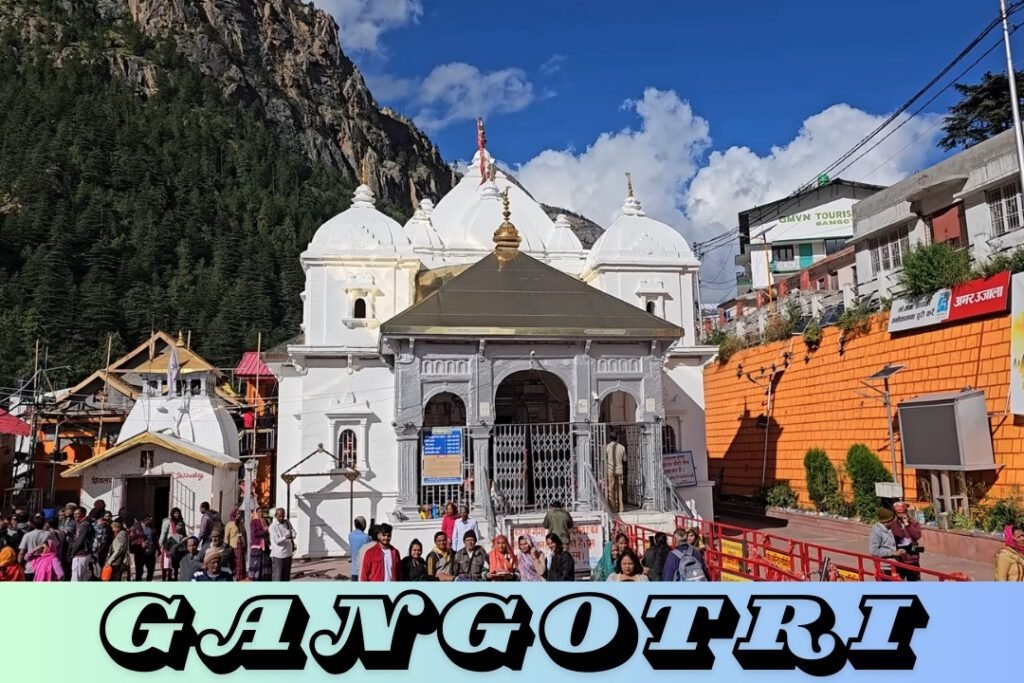
Table of Contents
Key Points
Historical and Mythological Significance
Mythological Origins
The story of Gangotri is deeply rooted in Hindu mythology, particularly in the legend of King Bhagirath. According to the scriptures, the sage Kapila cursed the sons of King Sagara, turning them to ashes. To purify their souls and liberate them from the curse, King Bhagirath undertook severe penance to bring the river Ganga down from the heavens. His prayers were answered, and Ganga descended, but such was her force that Lord Shiva had to capture her in his matted locks to prevent the Earth from being flooded. From Shiva’s locks, Ganga trickled down to the Earth, creating the Bhagirathi River, which later became the Ganges.
This divine event is commemorated at Gangotri, where the river is worshipped as a goddess. The place where Ganga first touched the Earth is marked by the Gangotri Temple, making it a site of immense religious importance. The Ganga’s descent is celebrated annually during the Ganga Dussehra festival, drawing thousands of devotees to the town.
Historical Background
The Gangotri Temple, a central feature of the town, was built in the early 19th century by the Gorkha general Amar Singh Thapa. The temple’s white marble structure has stood the test of time, remaining a beacon of faith for millions of Hindus. Despite its remote location, Gangotri has been a significant pilgrimage site for centuries, attracting devotees from across India and beyond.
Gangotri Temple: The Heart of the Town
Architectural Splendor
The Gangotri Temple is a simple yet elegant structure made of white marble, standing out against the rugged Himalayan landscape. The temple’s architecture is typical of the region, with a sanctum sanctorum that houses the idol of Goddess Ganga. The temple is surrounded by smaller shrines and guesthouses that accommodate pilgrims. The peaceful environment and the sound of the river flowing nearby add to the temple’s spiritual ambiance.
Temple Rituals and Festivals
The temple is the focal point of all religious activities in Gangotri. Daily rituals, including the morning and evening aarti (prayer ceremonies), are conducted with great reverence. The evening aarti, in particular, is a mesmerizing experience as priests perform the ritual by the riverside, offering lamps and flowers to the river while chanting hymns. The entire area is illuminated by the lamps, creating a divine atmosphere. Gangotri is most vibrant during the festival of Ganga Dussehra, which celebrates the descent of the Ganga to Earth. The temple is beautifully decorated, and special prayers and rituals are conducted throughout the day. Another significant event is the closing ceremony of the temple, which takes place on Diwali. The idol of Goddess Ganga is carried in a procession to the nearby village of Mukhba, where it is worshipped during the winter months until the temple reopens in spring.
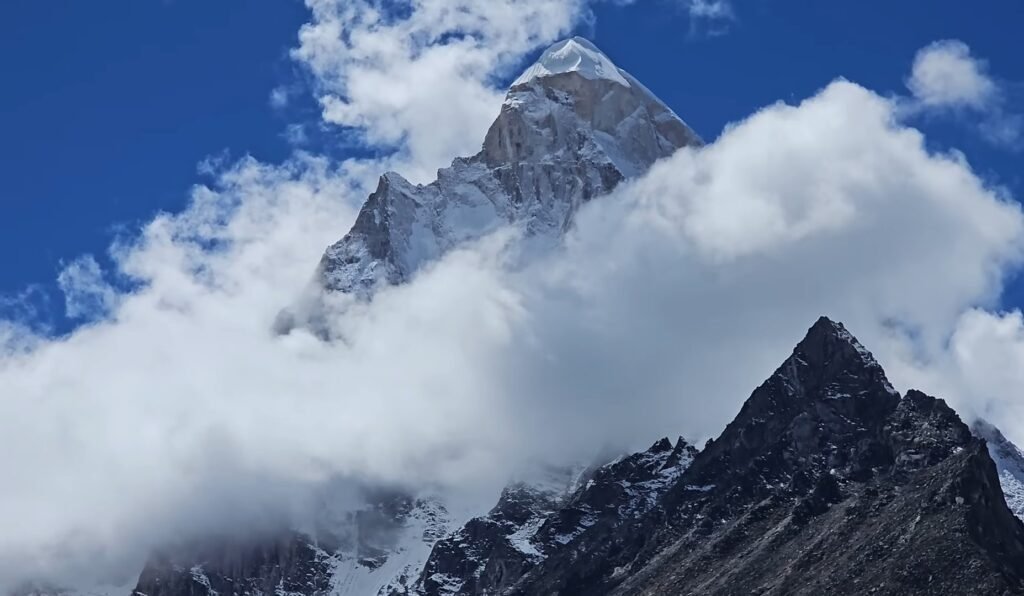
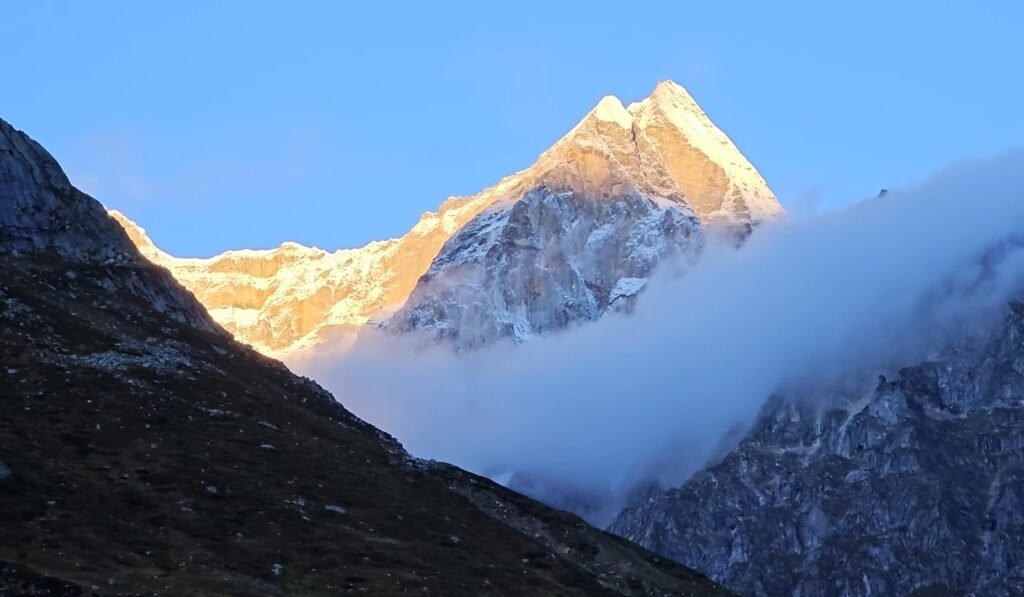

Cultural and Religious Practices
Daily Life in Gangotri
The daily life of the residents of Gangotri is deeply intertwined with their spiritual beliefs. The locals are primarily involved in serving the pilgrims, whether by running guesthouses, shops selling religious items, or guiding trekkers. The rhythm of life in Gangotri is slow and peaceful, reflecting the spiritual essence of the town. The community is small but close-knit, with a strong sense of tradition and religious duty.
Local Festivals and Celebrations
In addition to Ganga Dussehra, Gangotri celebrates several other festivals with great enthusiasm. Janmashtami, the birth of Lord Krishna, and Diwali, the festival of lights, are celebrated with rituals, prayers, and communal feasts. The temple and the town are adorned with lights and flowers, and the atmosphere is one of joy and devotion. These festivals offer a glimpse into the vibrant cultural life of Gangotri and provide a deeper understanding of the town’s spiritual heritage.
Exploring Beyond Gangotri
Other Pilgrimage Sites
After visiting Gangotri, many pilgrims continue their journey to the other sites in the Chota Char Dham circuit. Yamunotri, the source of the Yamuna River, is located to the west of Gangotri and is another important pilgrimage site. Kedarnath, dedicated to Lord Shiva, is renowned for its ancient temple and stunning location surrounded by snow-capped peaks. Badrinath, dedicated to Lord Vishnu, is the final destination in the circuit and is known for its colorful temple and the nearby hot springs.
Nearby Villages and Trekking Routes
There are several small villages near Gangotri that offer a glimpse into the traditional Himalayan way of life. Villages like Harsil, Mukhba, and Dharali are known for their apple orchards, terraced fields, and warm hospitality. These villages are excellent places to explore on foot, offering easy day hikes with beautiful views. For more adventurous trekkers, there are several challenging routes that lead to remote valleys, glacial lakes, and high passes. These treks offer a unique combination of physical challenge, natural beauty, and spiritual exploration.
Surrounding Attractions of Gangotri
The Bhagirathi River
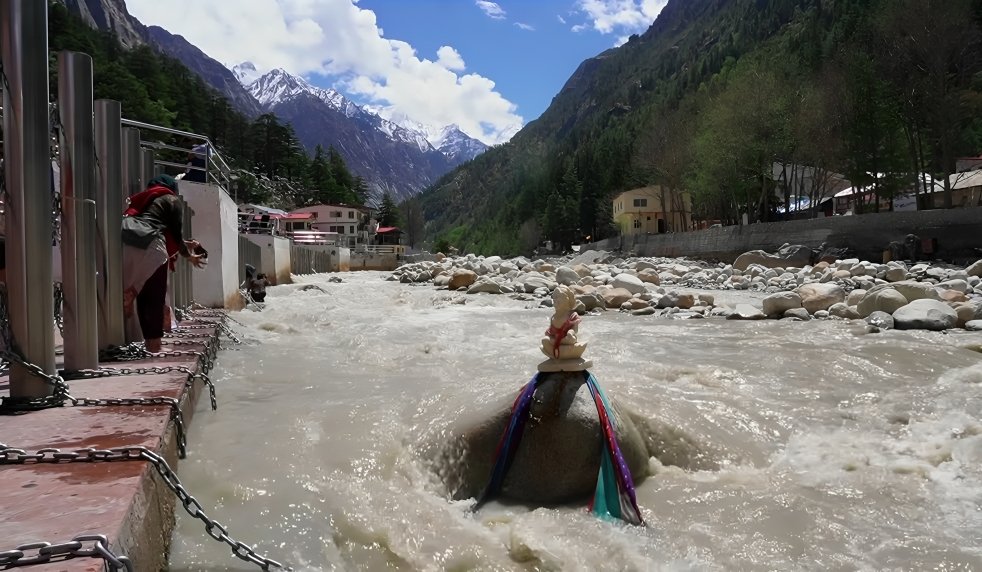
Scenic Beauty: The river’s journey through the mountains creates stunning landscapes, with crystal-clear waters, dramatic gorges, and serene valleys. The Bhagirathi River is a photographer’s delight and a source of inspiration for nature lovers.
Origin and Course: The Bhagirathi River originates from the Gomukh Glacier, which is located near Gangotri. It is considered the source stream of the Ganges, flowing through the rugged terrain of the Garhwal Himalayas before merging with the Alaknanda River at Devprayag to form the Ganges.
Spiritual Significance: The river holds immense religious importance in Hinduism, being worshipped as a goddess. Devotees believe that a dip in its icy waters can cleanse sins and purify the soul.
Adventure Activities: The river is popular for adventure sports like river rafting and kayaking, especially in the lower stretches where the water flow is more turbulent. The surrounding area also offers excellent trekking opportunities.
Cultural Heritage: Along its course, the Bhagirathi River passes through several towns and villages, each with its unique cultural heritage. The river is central to the daily lives of the local communities, influencing their traditions, rituals, and festivals.
Surya Kund
Spiritual Significance: Surya Kund is a sacred water spring located near Gangotri Temple. It is dedicated to the Sun God, Surya, and is a significant site for rituals and offerings made by pilgrims.
Natural Formation: The flowing water of the river Bhagir has created unique stone carvings. which divides Bhagirathi into 2 parts and goes back to the kund.

Scenic beauty: Surya Kund is surrounded by beautiful landscapes, creating a mesmerizing atmosphere with the sound of the flowing river.
Accessibility: Surya Kund is easily accessible from Gangotri Temple, requiring only a short walk. The area is well-maintained, with pathways and steps leading to the Kund, making it convenient for pilgrims and tourists.
Pandava Gufa
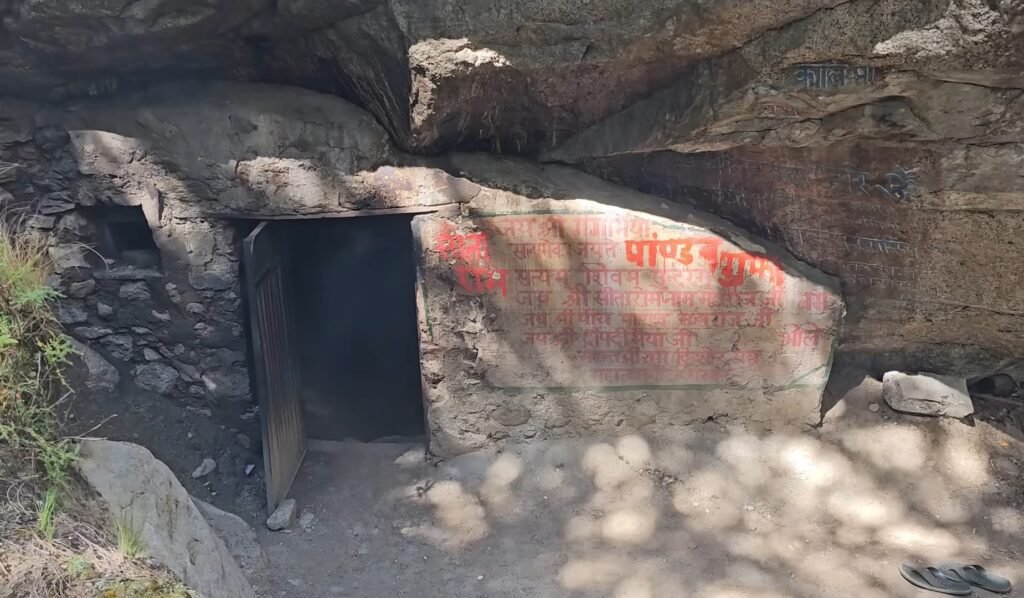
Natural Beauty: The cave is nestled amidst tall pine and deodar trees, offering stunning views of the surrounding mountains. The tranquility of the area, combined with the natural beauty, makes it a perfect spot for nature lovers.
Interior and Atmosphere: The cave is spacious, with a naturally formed altar where pilgrims offer prayers and meditate. The interior is cool and quiet, providing a perfect retreat from the hustle and bustle of the temple area.
Mythological Significance: Pandava Gufa is believed to be the cave where the Pandavas, the heroes of the Mahabharata, meditated during their journey to the Himalayas. This historical connection makes it a site of great religious importance.
Location and Access: The cave is located about 1.5 km from Gangotri, requiring a short trek through dense forests and rugged terrain. The trek offers a peaceful and serene environment, ideal for meditation and reflection.

Spiritual Retreat: Pandava Gufa is a popular spot for spiritual seekers and those interested in experiencing the meditative atmosphere of the Himalayas. The cave’s seclusion and serenity make it an ideal place for introspection and spiritual practices.
Gangotri National Park
Biodiversity: Gangotri National Park is home to a rich variety of flora and fauna. The park’s diverse ecosystems include coniferous forests, alpine meadows, and high-altitude deserts. It is a habitat for rare species like the snow leopard, Himalayan black bear, blue sheep, and musk deer.
Trekking and Adventure: The park is a popular destination for trekkers and adventure enthusiasts. The trek to Gaumukh Glacier and further to Tapovan passes through the park, offering breathtaking views of the Himalayan peaks and the chance to encounter wildlife.
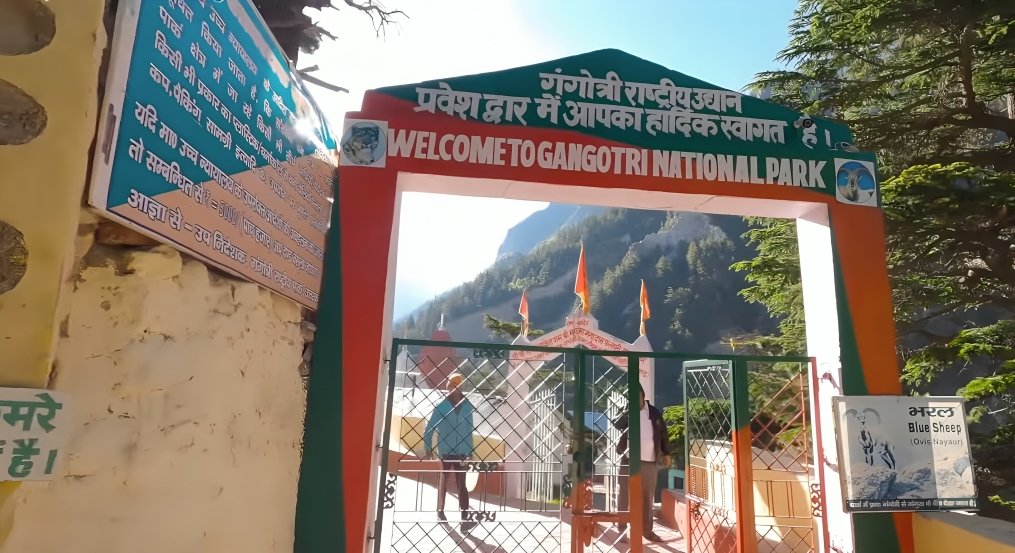
Conservation Efforts: The park is a protected area, and significant efforts are made to conserve its unique ecosystems. The park’s management focuses on preserving the delicate balance of nature while promoting sustainable tourism.
Scenic Landscapes: The park offers stunning landscapes, including dense forests, flowing rivers, and snow-capped mountains. The changing seasons bring different colors and moods to the park, making it a paradise for photographers and nature lovers.
Cultural and Spiritual Heritage: Gangotri National Park is not just about natural beauty; it also holds cultural and spiritual significance. The park includes sacred sites like Gomukh, the source of the Ganges, and is a place of pilgrimage for Hindus.
Gomukh Glacier (Gangotri Glacier)

Spiritual Significance: Gaumukh holds immense spiritual significance as the starting point of the holy Ganges. Pilgrims and spiritual seekers often visit the glacier to witness the source of the river and to meditate in the serene environment.
Environmental Concerns: The glacier has been receding over the years due to climate change, raising concerns about the future of the Ganges. Efforts are being made to monitor the glacier’s health and to promote awareness about environmental conservation.
Source of the Ganges: Gomukh Glacier is the origin point of the Bhagirathi River, which later becomes the Ganges. The glacier’s name, meaning “cow’s mouth,” comes from its shape, which resembles the mouth of a cow.
Trekking Destination: The trek to Gomukh is one of the most popular in the Gangotri region. The 19-km trek from Gangotri takes you through dense forests, rocky terrains, and alpine meadows, offering stunning views of the surrounding peaks.

Natural Beauty: The glacier is surrounded by some of the most majestic peaks in the Himalayas, including Shivling, Bhagirathi, and Meru. The pristine ice formations and the clear blue waters of the Bhagirathi River create a landscape of unparalleled beauty.
Tapovan
High-Altitude Meadow: Tapovan is a high-altitude meadow located beyond Gomukh Glacier, at an altitude of about 4,463 meters (14,640 feet). It is known for its lush green pastures, wildflowers, and clear streams, making it a paradise for trekkers and nature lovers.
Base Camp for Expeditions: Tapovan serves as a base camp for mountaineering expeditions to peaks like Shivling, Bhagirathi, and Meru. The area offers spectacular views of these towering peaks, making it a popular destination for climbers and adventure seekers.
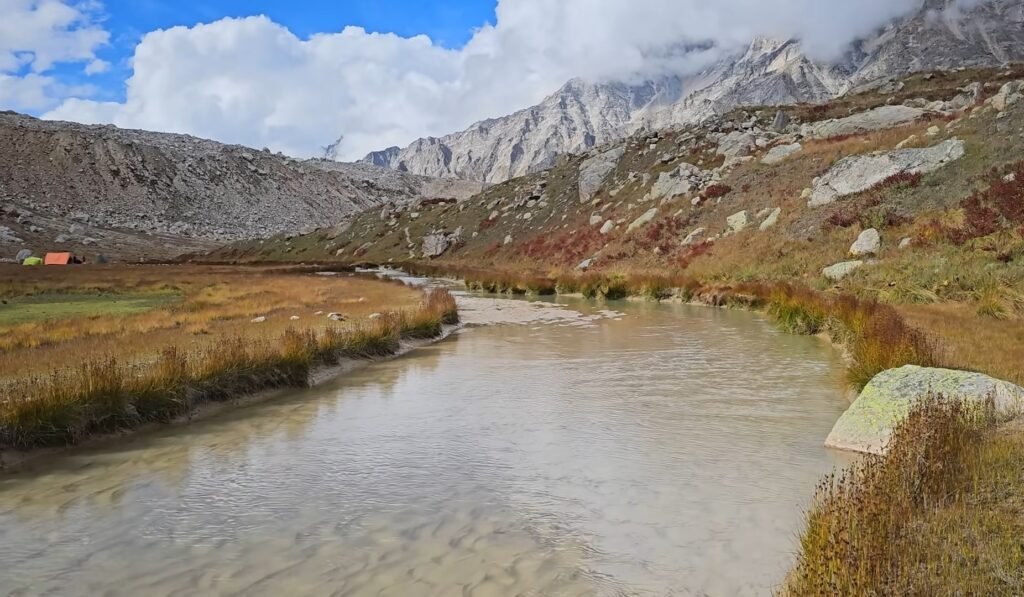
Spiritual Significance: Tapovan is a place of great spiritual importance, often visited by sadhus and yogis who come here to meditate and perform penance. The name “Tapovan” means “forest of penance,” reflecting its spiritual aura.
Challenging Trek: The trek to Tapovan is challenging, requiring trekkers to cross the Gomukh Glacier and navigate steep ascents. The journey is physically demanding but offers rewards in the form of stunning vistas and a sense of accomplishment.
Pristine Environment: Tapovan is known for its untouched natural beauty and peaceful environment. The area is free from human habitation, allowing visitors to experience the true wilderness of the Himalayas. The serene atmosphere makes it an ideal place for meditation and solitude.
How to Reach
By Air
Nearest Airport: The nearest airport to Gangotri is Jolly Grant Airport in Dehradun, which is about 250 km away.
Connecting Flights: Jolly Grant Airport is well-connected to major cities in India like Delhi, Mumbai, Bangalore, and others.
Travel Time: The drive from Jolly Grant Airport to Gangotri takes around 10-11 hours, depending on road conditions and weather.
By Train
Nearest Railway Stations: The nearest railway stations to Gangotri are at Rishikesh (approximately 234 km away) and Haridwar (around 262 km away).
Train Connectivity: Both Rishikesh and Haridwar are well-connected by trains from major cities across India, including Delhi, Mumbai, Kolkata, and Varanasi.
Road Journey: From Rishikesh or Haridwar, you can hire a taxi or take a bus to reach Gangotri. The road journey from these stations to Gangotri takes about 10-12 hours.
By Road
Self Drive:
- From Dehradun: You can drive or take a taxi from Dehradun to Gangotri. The route passes through Mussoorie, Uttarkashi, and Harsil, offering scenic views along the way.
- From Rishikesh or Haridwar: Regular buses and taxis are available from Rishikesh and Haridwar to Gangotri. The route is the same as from Dehradun, passing through picturesque landscapes and small hill towns.
Private and Shared Taxis: Private taxis can be hired for a more comfortable journey, while shared taxis are available for budget travelers. The roads are winding and can be challenging, so hiring an experienced driver is recommended.
Bus Services: State-run and private buses operate from Rishikesh, Haridwar, and Dehradun to Gangotri. Buses are the most economical option but may take longer due to frequent stops.
Trekking to Gangotri
For Adventurers: Some adventurers and pilgrims prefer to trek parts of the journey to Gangotri from nearby towns like Harsil or Uttarkashi. This allows for a closer experience of the region’s natural beauty.
Trekking Routes: There are several trekking routes that pass through the dense forests and valleys of the Garhwal Himalayas, offering stunning views and a spiritual journey.
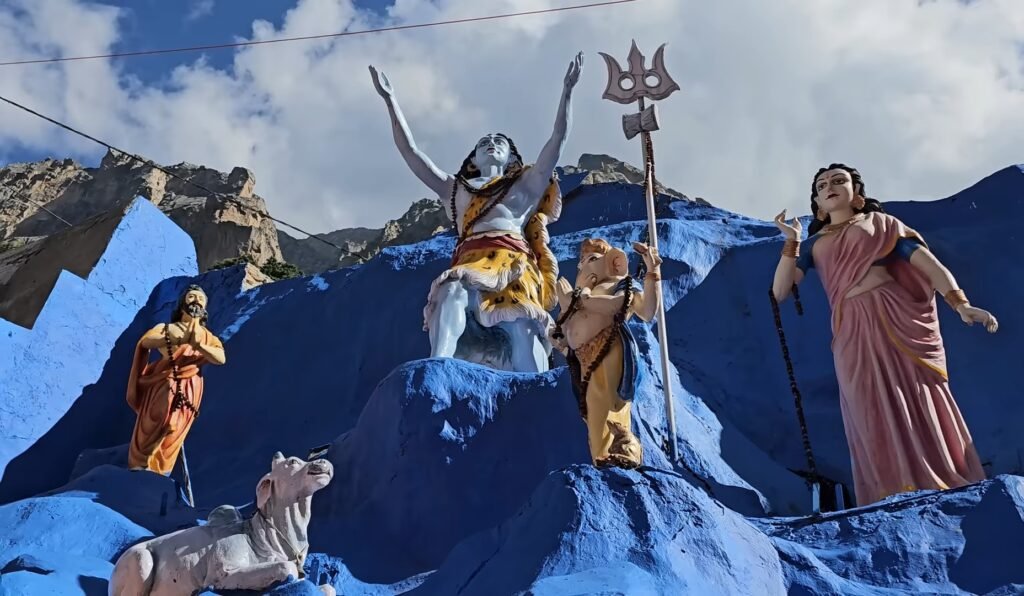
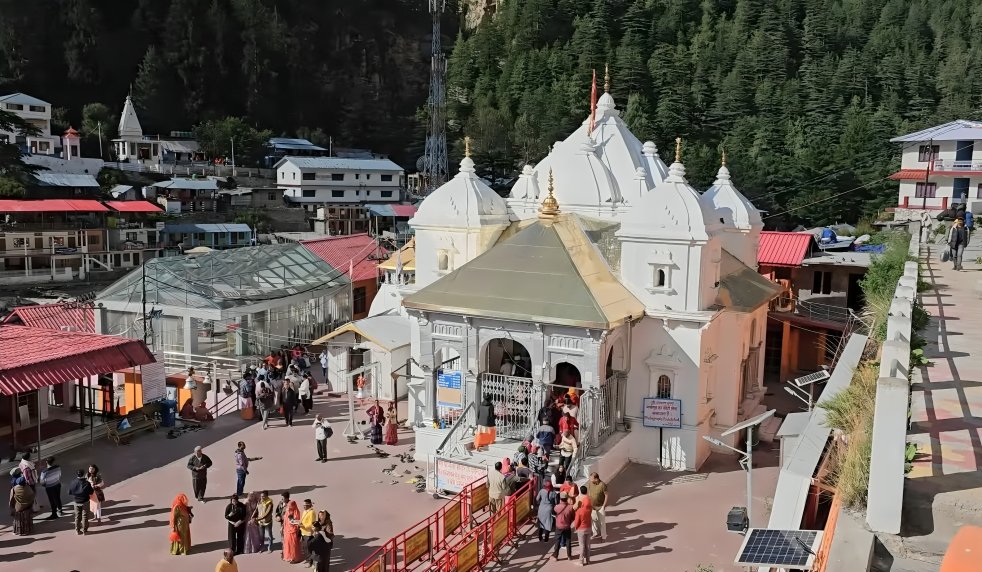
Accommodations
GMVN Tourist Rest Houses
- Government Accommodation: The Garhwal Mandal Vikas Nigam (GMVN) operates tourist rest houses in Gangotri. These rest houses are basic but clean and offer a good option for budget travelers.
- Location: These rest houses are conveniently located near the main temple and other key spots in Gangotri, making them a popular choice for pilgrims.
Hotels and Guesthouses
- Budget Hotels: There are several budget hotels in Gangotri that offer basic rooms with essential amenities. These are ideal for pilgrims and travelers who are looking for an economical stay.
- Mid-Range Hotels: Some mid-range hotels offer more comfortable accommodations with better amenities, including attached bathrooms, hot water, and room service. These hotels may also have in-house restaurants offering vegetarian meals.
- Location: Many hotels are located within walking distance of the Gangotri Temple, providing easy access to the main attraction.
Ashrams and Dharamshalas
- Spiritual Stay: For those seeking a more spiritual experience, several ashrams and dharamshalas in Gangotri offer accommodation. These are often very basic but are imbued with a serene atmosphere.
- Community Experience: Staying in an ashram allows travelers to immerse themselves in the spiritual ambiance of Gangotri, often participating in prayers and rituals.
Tent Accommodations and Camps
- Adventure Stay: For trekkers and adventure seekers, there are tent accommodations and campsites available near Gangotri. These are especially popular with those embarking on treks to Gaumukh and Tapovan.
- Facilities: Tents are usually equipped with sleeping bags, mattresses, and basic camping facilities. Some camps also offer meals, guides, and porters.
- Scenic Locations: Campsites are often located in scenic spots with beautiful views of the surrounding mountains and the Bhagirathi River, providing a closer connection to nature.
Home Stays
- Local Experience: In nearby villages like Harsil and Dharali, some locals offer homestay accommodations.
- Facilities: Homestays are typically modest but comfortable, offering home-cooked meals and a chance to interact with the host family. This option is ideal for travelers looking for an authentic local experience.
Luxury Options
- Limited Availability: While Gangotri primarily caters to pilgrims and budget travelers, there are a few higher-end accommodations available in the nearby areas like Harsil. These offer more luxurious rooms and amenities.
Local Cuisine
Aloo Ke Gutke: A traditional dish made with boiled and sautéed potatoes, flavored with local spices like cumin, coriander, and turmeric. It’s a popular side dish that is often served with chapati or rice.
Chainsoo: A hearty dish made from black gram (urad dal) that is roasted and ground before being cooked with spices. It’s a protein-rich dish, typically enjoyed with rice.
Mandua Ki Roti: Mandua, or finger millet, is a staple grain in the Uttarakhand region. The roti made from mandua flour is nutritious and has a slightly earthy flavor. It’s often eaten with ghee or served with local curries.
Jhangora Ki Kheer: Jhangora is a type of millet used to make a sweet pudding, or kheer, that’s flavored with cardamom, sugar, and sometimes garnished with nuts. This dessert is both hearty and satisfying.
Local Lentil Dish: This dish is made from black soybeans (bhatt) cooked in an iron kadhai (wok) with a mix of spices. It’s a nutritious and warming dish, often served with rice or roti, and is particularly popular in colder months.
Butter Tea: Inspired by the Tibetan tradition, butter tea (also known as po cha) is a salty tea made with tea leaves, yak butter, and salt. It’s an acquired taste but is very effective in keeping warm in the cold weather.
Pahadi Raita: A cooling side dish made from yogurt and local cucumber or radish, seasoned with mustard seeds, cumin, and coriander. It’s often served alongside main meals to balance the spiciness.
Saag (Leafy Greens): Various types of leafy greens are grown locally and used in dishes like saag, where the greens are sautéed with garlic, ginger, and spices. It’s a simple yet flavorful dish that’s packed with nutrients.
Singori: A traditional sweet made from khoya (thickened milk) and coconut, wrapped in maalu leaves. The distinct flavor of the leaves imparts a unique taste to the sweet, making it a must-try delicacy.
Bal Mithai: Although more popular in other parts of Uttarakhand, Bal Mithai, a fudge-like sweet coated with sugar balls, can sometimes be found in Gangotri. It’s a delightful treat to enjoy after a meal.
Travel tips and Safety advice
Best Time to Visit
- Ideal Season: The best time to visit Gangotri is from May to early June and September to October. During these months, the weather is good, and the temple is open for pilgrims.
- Avoid Monsoon: The monsoon season (July to August) brings heavy rainfall, which can lead to landslides and road blockages. It’s best to avoid traveling to Gangotri during this time.
Acclimatization
- High Altitude: Gangotri is located at an altitude of 3,100 meters (10,200 feet). Proper acclimatization is essential before going to altitude. Spend a day in a lower-altitude area like Uttarkashi or Harsil before heading to Gangotri.
- Stay Hydrated: Drink plenty of water to stay hydrated, and avoid strenuous activity on your first day at high altitude.
Packing Essentials
- Warm Clothing: Even during the summer, temperatures in Gangotri can drop significantly, especially at night. Pack warm clothing, including thermal wear, woolen sweaters, and jackets.
- Rain Gear: Carry a raincoat or waterproof jacket, especially if you’re visiting during the early or late part of the monsoon season.
- Footwear: Wear sturdy, comfortable shoes suitable for walking and trekking on uneven terrain. If you plan to trek to Gomukh or Tapovan, proper trekking boots are recommended.
- First-Aid Kit: Include basic medications for altitude sickness, headaches, nausea, and any personal prescriptions. A first-aid kit is crucial, as medical facilities in Gangotri are limited.
Health and Safety
- Altitude Sickness: Be aware of the symptoms of altitude sickness, such as headaches, dizziness, nausea, and fatigue.
- Pilgrimage Etiquette: Gangotri is a sacred site for Hindus. Dress modestly and respect local customs and traditions. Avoid littering and keep the environment clean.
- Food and Water: Drink only bottled or boiled water, and eat at clean and reputable eateries. Avoid raw or uncooked foods to prevent stomach issues.
Connectivity
- Mobile Network: Mobile connectivity is limited in Gangotri. BSNL is the most reliable network, but even that can be spotty. Inform your family and friends in advance of limited connectivity.
- Power Supply: Power cuts are common in Gangotri. Carry a power bank to keep your devices charged, especially if you’re using your phone for navigation or photography.
Permits and Documentation
- Inner Line Permit: If you plan to trek to Gomukh or Tapovan, you need to obtain an Inner Line Permit from the Forest Department in Uttarkashi. Make sure to carry valid ID proof for this purpose.
- Identification: Always carry a government-issued ID, as you may be required to present it at various checkpoints or when booking accommodations.
Trekking Tips
- Gomukh Trek: If you’re trekking to Gomukh, ensure that you’re physically fit and have prepared adequately for the trek. The trail can be challenging, with steep ascents and rocky paths.
- Guides and Porters: Hire a local guide or porter and enhance your trekking experience. They can help you navigate the trails and carry your gear, making the trek easier.
- Leave No Trace: Follow eco-friendly practices while trekking. Do not litter, and respect the natural environment by staying on marked trails.
Local Customs and Rituals
- Temple Rituals: Participate in the temple rituals with reverence. Photography inside the temple may be restricted, so always ask for permission before taking pictures.
- Holy Dips: If you plan to take a dip in the Bhagirathi River, be cautious of the strong currents. It’s advisable to take a dip near the ghats where the water is calmer.
Conclusion
Gangotri is more than just a pilgrimage site; it is a place where spirituality, nature, and culture come together in perfect harmony. The town’s significance as the source of the Ganges, combined with its stunning natural surroundings, makes it a destination of profound spiritual and aesthetic beauty. Whether you are seeking spiritual enlightenment, adventure, or simply a retreat from the stresses of modern life, Gangotri offers an experience that is both transformative and unforgettable. The journey to Gangotri is not just a physical one; it is a journey of the soul, a pilgrimage to the heart of the Himalayas, and a step closer to the divine.

Frequently Asked Questions (FAQs)
What is the significance of Gangotri?
Gangotri is one of the four Char Dham pilgrimage sites in Uttarakhand and is considered the origin of the holy river Ganga (Ganges). The Gangotri Temple is dedicated to Goddess Ganga, and it is believed that the river descended to earth here after being released by Lord Shiva from his locks. Pilgrims visit Gangotri to pay homage to the Ganga and seek blessings.
When is the best time to visit Gangotri?
The best time to visit Gangotri is from May to June and September to October. During these months, the weather is pleasant, and the temple is open for visitors. The monsoon season (July to August) should be avoided due to landslides and road closures, while the temple is closed in winter (November to April) due to heavy snowfall.
How can I reach Gangotri?
Gangotri can be reached by road from major cities like Dehradun, Rishikesh, and Uttarkashi. The nearest airport is Jolly Grant Airport in Dehradun, about 250 km away, and the nearest railway stations are in Dehradun and Rishikesh. From these locations, you can hire a taxi or take a bus to Gangotri.
Is Gangotri suitable for elderly travelers?
Gangotri is accessible to elderly travelers, but it is situated at a high altitude of 3,100 meters (10,200 feet). Elderly visitors should take precautions against altitude sickness and travel at a comfortable pace. It’s advisable to consult a doctor before the trip and ensure proper acclimatization. The walk to the temple from the parking area is relatively short and manageable for most.
What are the main attractions around Gangotri?
The main attractions around Gangotri include the Bhagirathi River, Surya Kund, Pandava Gufa, Gangotri National Park, Gaumukh Glacier (the source of the Ganges), and Tapovan. These sites offer a mix of spiritual, natural, and adventurous experiences.
Is there accommodation available in Gangotri?
Yes, Gangotri offers a variety of accommodation options, including GMVN tourist rest houses, budget hotels, guesthouses, ashrams, and campsites. The accommodations are generally basic but sufficient for pilgrims and trekkers. It’s advisable to book in advance, especially during peak pilgrimage season.
What should I pack for a Travel to Gangotri?
When visiting Gangotri, pack warm clothing regardless of the season, as temperatures can drop significantly, especially at night. Bring sturdy trekking shoes, a hat, sunglasses, sunscreen, and essential medicines. Don’t forget to carry your identification, permits for trekking, and a first aid kit.
Are there any trekking opportunities in Gangotri?
Yes, Gangotri is the starting point for several popular treks, including the trek to Gaumukh Glacier and Tapovan. These treks offer stunning views of the Himalayas and are popular among adventure enthusiasts. Trekkers need to obtain permits from the Forest Department and should be well-prepared for high-altitude trekking.
What is the altitude of Gangotri, and how can I avoid altitude sickness?
Gangotri is located at an altitude of 3,100 meters (10,200 feet). To avoid altitude sickness, it’s important to acclimatize properly by spending a day or two at lower altitudes like Uttarkashi or Harsil before proceeding to Gangotri. Drink plenty of water, avoid alcohol, and take it easy when you first arrive.
Is there mobile network connectivity in Gangotri?
Mobile network connectivity in Gangotri is limited. BSNL provides the most reliable service in the area, but signals can be weak or nonexistent in certain spots. It’s advisable to inform family and friends about potential communication gaps before your trip.
Are there any restrictions on photography in Gangotri?
Photography is generally allowed in most areas around Gangotri, but taking photos inside the Gangotri Temple is usually prohibited. Always ask for permission before photographing locals or religious sites, and be respectful of the sanctity of the location.
What kind of food is available in Gangotri?
The food available in Gangotri is primarily vegetarian due to its religious significance. You’ll find local Pahadi cuisine, including dishes like Aloo Ke Gutke, Mandua Ki Roti, and Bhatt Ki Churdkani. Simple North Indian meals like dal, rice, and chapati are also commonly served in dhabas and guesthouses.

